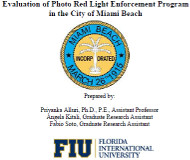2/1/2019
Florida Studies Find No Significant Reduction In Accidents From Red Light CamerasNew study of red light cameras in Miami Beach, Florida fails to demonstrate a clear benefit to red light cameras.

Miami Beach, Florida, appears to be moving forward with more red light cameras despite the lack of clear evidence that they have provided any statistically significant accident reduction. A report released in December painted photo enforcement results in the most favorable light possible, but the raw figures show little benefit compared to the intersections that did not use automated enforcement.
The city paid Florida International University $13,500 to come up with this report in the hopes that city commissioners could cite it as justification for renewing the photo ticketing deal. The contract commissioning the study ensured the city manager had full access to review report drafts at any time and cancel the project entirely if the results failed to suit the city's purposes.
The study examined five years of accident data covering two years before the installation of cameras in April 2010, and three years after they were installed at nine intersections. Accidents at camera locations were compared against 19 control intersections that had no photo ticketing devices. The research team manually went through police reports to delete accidents they believed were caused by adverse weather, driver distraction, drunk driving or fatigue.
"The presence of red light cameras at the study intersections tend to increase rear-end crashes and decrease angle/left-turn/right-turn and sideswipe crashes," the study found. "This observation is consistent with several other previous studies that have focused on analyzing the effectiveness of red light cameras at intersections."
At the same time, however, the control intersections that did not have any red light cameras experienced a reduction in both angle and rear-end crashes. A more sophisticated statistical analysis that took this into account concluded that "target crashes resulting in injuries slightly increased" at the photo-enforced locations.
A 2015 Florida International University doctoral thesis by Anthoni F. Llau Jr looked at broader impact of red light cameras throughout Miami-Dade County over the same period as the Miami Beach study (read dissertation). The thesis examined twenty camera-enforced intersections that were paired with forty control intersections without cameras.
"During the first year, the red light camera sites experienced a marginal decrease (-3 percent) in right-angle/turn collisions (119 observed collisions vs. 123 expected)," Llau wrote. "In contrast, a significant increase in rear-end collisions (+40 percent) was observed at the red light camera sites (302 actual collisions vs. 215 expected) according to the Empirical Bayes analysis."
The net result was an overall increase in the number of accidents where cameras were used. The author noted that in July 2012, the state changed definitions for intersection accidents as occurring within 250 feet instead of 150 feet, affecting the number of accidents counted in the "after" period.
"Changes in crash reporting requirements likely resulted in an increase in the magnitude of rear-end collisions and a slight increase in right-angle/turning collisions after two years of camera enforcement," Llau observed. "Results suggest, however, that the effect of red light cameras on right-angle/turning crashes is minimal, even with changes in reporting."
The thesis findings are reflected statewide. According to the Department of Highway Safety and Motor Vehicles, red light cameras did nothing to improve safety across 31 cities in the Sunshine State. A comparison of accidents before and after the devices were installed showed a 15 percent increase in the total number of collisions where photo enforcement was used (read report).
Despite the results, Florida lawmakers have been reluctant to curtail the use of cameras. According to the staff analysts for the House of Representatives, red light cameras are expected to generate a total of $393 million in profit for the state through fiscal year 2023. Local jurisdictions likewise will see $391 million in gross revenue.
A copy of the new study is available in a 1.7mb PDF file at the source link below.


